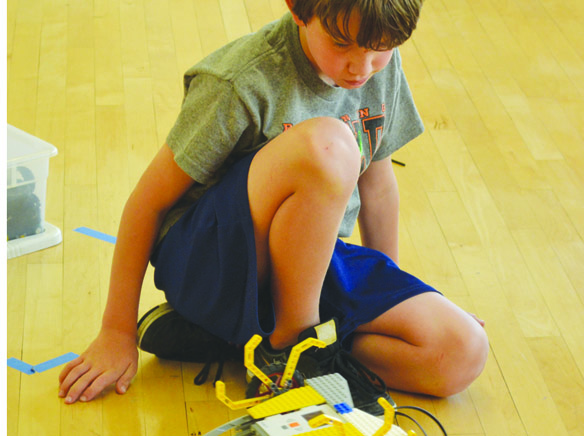You don’t have to go any further than a holiday camp at the La Mesa Recreation Center (LMRC) to feel like the younger generation is having more fun than it’s predecessors – while getting smarter in the process.
You don’t have to go any further than a holiday camp at the La Mesa Recreation Center (LMRC) to feel like the younger generation is having more fun than it’s predecessors – while getting smarter in the process.
Play-Well TEKnologies set up shop with their Lego camp at the LMRC in late December/early January as they have done in years past with sessions for local children. From the outside looking in, 5 to 14-year-olds look like they’re playing with the toy pieces known as Legos. But under the direction of Play-Well’s Nick Diaz and Mike Sidebottom, the children were engaged in much more complex activities. “They learn critical thinking, engineering and problem solving, with Legos as the medium,” said Diaz, who has been with Play-Well for four years. It’s not as silly as it sounds, in fact, it required quite a bit of hands-on as well as intellectually demanding work to accomplish the camper’s goal, which was to create and program a Lego robot.
The Lego camp was a week long, with New Year’s Day off. The camp’s laid-back atmosphere might have been enjoyable, but it challenged even the most tech-savvy campers. The kids laughed and bonded, scooted happily on their knees after their robots, but had to constantly stop and make adjustments to their robots with the Lego Mindstorm software, on which they programmed their robots.
In the morning session from 9:00 a.m. to noon, children ages 5-9 learned to build with Legos. In the afternoon camp from 1:00-4:00 p.m., kids ages 9-14 learned to program what they built with devices that will respond to commands. Campers chose sensor inputs that enabled the robots to respond to sound, color, distance, and to move. “The way that whales and bats echolocate, this sensor kind of does the same thing,” said Diaz, holding up an ultrasonic sensor.
The campers displayed frustration to total elation while using their own mind power to get a machine to do what they wanted.
“When the sensors are involved, they have to manage input and output. They engineer the software aspect. This is where they learn that it’s not just about the hardware building part of it,” said Sidebottom. “But that once you build something, you need to be able to tell it what to do so it can function on it’s own.”
The idea for Play-Well was born of one person’s curiosity about how things worked – a television – taking it apart, putting it back together, and then teaching that basic engineering in a classroom, Diaz explained. That curiosity took off, and now Play-Well has camps and classes in Southern California as well as nationwide, even a hub in Paris, France.
Use of play as a tool for problem solving is successful, and Play-Well held corporate events. They also do birthday parties and have activity centers in California and Washington.
The camp was a mix of girls and boys, from elementary school to middle school aged kids. When asked what the best thing about Lego camp was, “building stuff,” was the most common response, as the children were busy programming, testing and re-programming their robots. There was no stereotypical, engineering-type kid that made up the majority at the Lego camp. The learning of complex systems was allowed to take a non-pressured pace, with some campers working in groups, others individually. It was camp for Gen Y, for whom technology is the common denominator and equalizer, while the need for play is still the great unifier.














